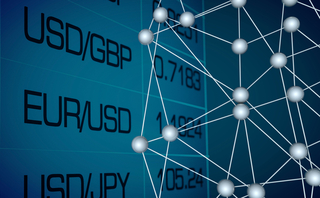
LiquidityBook looks to displace Fidessa as sell-side OMS of choice
What began as a small buy-side technology offering, now has ambitions to oust Fidessa in the sell-side OMS space. LiquidityBook, now armed with a handful of ex-Fidessa employees, has secured the product expertise. Can it secure the clients?
A lot can happen in 21 years. Given that timeline, a blue moon will rise in the night sky seven times. The majority of atoms in a human body will replace themselves about three times. A newborn in the United States will be able to buy a drink at a bar. And sometimes, when enough time is paired with serendipity, someone will get a chance to do what they wish they could have those many years ago.
Recently, Sayant Chatterjee joined a call with his colleague at LiquidityBook, Ryan Stankus, who joined the trading technology provider late last year at the urging of Chatterjee, the company’s chief operating officer. They reminisced on the early days of their careers when the two had worked together at Fidessa, the UK-based trading solutions provider best known for its order management system (OMS) that’s become woven into the fabric of global equities trading.
“You know,” Chatterjee recalls his colleague telling him on the phone, “this is our chance to be our better selves—to do what we did before at Fidessa, but in a better way.”
Chatterjee had joined Fidessa—then called Royalblue—in 2001 as an early addition to the product team. By 2012, he was a managing director. Stankus had joined in 1998 as a technical support specialist and, after a handful of other roles, moved up to product manager in 2020. Though the two left Fidessa, which was bought by Ion Group in 2019 for a whopping $2 billion, their knowledge of the product, and the business, has predicated a new, daring ambition for LiquidityBook: doing it all again.
David and Goliath
This past February, the company announced three strategic hires: Stankus, who joined as vice president of product management and who works closely with Chatterjee to oversee all aspects of sell-side product management; Brian Cabra as new vice president of implementations, and who was at Fidessa/Ion Markets from 2011 to 2020; and Terrence Cheung, vice president of post-trade product management, who worked for Fidessa from 2006 to 2018.
The gang was getting back together.
We started with a buy-side system because that’s what our initial clients required. Can you take a buy-side system and make it a sell-side system? I think you can. I didn’t a year ago.
Sayant Chatterjee, LiquidityBook
And the gang had watched, some from within and some from new postings, the hectic takeover of Fidessa by Ion. Hundreds of employees left in the first year after the acquisition. And banks especially, knowing Ion’s reputation for austere cost-cutting and sticky contracts, debated whether to rip out a critical piece of trading infrastructure and search for a comparable product or lock themselves in and hope for the best.
The ordeal also provided an opportunity for a litmus test, albeit one that would require significant work on both the technical and the messaging ends. (A spokesperson for Fidessa declined to comment on questions about LiquidityBook, stating that “Ion-Fidessa’s OMS has been developed to support the unique and specific needs of clients as they evolve. Ion continues to invest in Fidessa’s platforms and upgrades are made on a routine basis.”)
Staffed only by roughly 50 US-based employees, the company would need to do three things. First, it will need to change the fact that when industry participants hear the name “LiquidityBook”, they currently think of a buy-side order and execution management system (OEMS). Second, it will have to prove that one single technology can be so versatile, it can serve the hugely different workflows and use-cases that separate the buy side from the sell side.
And third—and perhaps most importantly—LiquidityBook will have to prove that one single tech platform is a better option than those of the major incumbent vendors—players such as Fidessa, FlexTrade, and Bloomberg, each of which still use separate systems to manage the OMS needs of their buy-side and sell-side clients. (It should be noted that Bloomberg’s sell-side OMS, dubbed Toms, is solely used for fixed-income trading, and that its broader sell-side OMS business ceased operations last year.)
“We’re where Fidessa was in the US in 2001,” Chatterjee says—which is to say, at the beginning.
One system, dual purposes
Founded in 2005, LiquidityBook offers a suite of multi-asset trading tools, but it’s best known for its flagship platform LBX, which is popular among outsourced trading providers, hedge funds, and asset managers. The company’s proposition is that the exact same cloud-based LBX system is also a sell-side platform ready for broker-dealer use.
A second key differentiator for the platform is its singular code base, which means LiquidityBook doesn’t write custom code for clients—even complex ones—and instead implements new capabilities as configuration settings or as rules in one of the product’s rule engines.
But the biggest draws, Chatterjee hopes, lie in LBX’s multi-tenant system and data manipulation capabilities. Clients can be represented as multiple companies in the system, and each can have their own unique setup if needed, such as in the instance of a broker having different regional and asset class desks—but with only one install required.
When it comes to data, the use-case for a buy-side OMS and a sell-side OMS comes down to data—what kind of data, when it flows through the platform, and what it means for the person sitting behind the screen. The data, and thereby the ease of using an OMS, is always siloed by asset class. But another world is possible, Chatterjee says.
“If you look at all the data, it’s really all the same. Trading data is just buys and sells, commissions and prices. So if it’s all very similar data, it makes sense to be able to manipulate all of that using a transaction framework in a very flexible way,” he says.
LiquidityBook’s belief that the sell side and buy side don’t require separate systems may be novel, but the urge to displace large, legacy OMS providers, and put some power in the hands of users, is alive, well, and shared by other former Fidessa employees, such as Steve Grob, founder and head of capital markets tech consultancy, Vision57.
Grob, who in 2020 began working with desktop application interoperability provider Glue42 to help legacy trading providers, including Fidessa, modernize their offerings, calls the requirement that a trader use separate OMS channels to do business in different asset classes “somewhat antiquated.” And he believes that industry pushes toward greater system interoperability and stronger standalone solutions are mounting threats to the old guard’s business model.
“The reason people bought one-stop-shop platforms like Fidessa was not because any one bit of it was brilliant—there were better point solutions for much of what it did—but because you got everything in one box,” Grob says of his old company, which through its platform offered analytics, market data services, global connectivity solutions, and other services. “The value of the OMS used to be having everything in one box, but now because I can buy smaller boxes and effectively glue them together, I think you’re seeing a transformation in how firms are thinking much more carefully about buying the best pieces of the jigsaw.”
Hearts and minds
When Chatterjee joined LiquidityBook in the spring of 2021, he wasn’t so much of a believer.
“We started with a buy-side system because that’s what our initial clients required,” he says. “Can you take a buy-side system and make it a sell-side system? I think you can. I didn’t a year ago.”
It took him about six months to buy into the idea. But he knows the company still has an uphill battle if they’re going to convince investment banks, especially tier-1s with complex needs, to go through the nightmare that is ripping out and replacing an OMS. Some industry observers believe that LiquidityBook might be biting off a bit more than it can chew.
“The sell-side OMS has to do some very specific things that the buy-side OMS doesn’t. It has to connect to liquidity pools—exchanges, dark pools, other brokers—whereas, the destination of a buy-side OMS or EMS is a broker network,” says a person familiar with the OMS space, who’s skeptical that a broker and an asset manager can use the same platform to meet their own needs. “The idea that you’ve got the buy side and the sell side both using the same functional line—I don’t think that makes sense to me.”
Though there’s been upheaval in the OMS realm—notably, the Fidessa acquisition and Bloomberg’s exit of its Sell-Side Execution and Order Management Solutions (Sseoms) line of business—the industry observer says firms aren’t necessarily thinking about replacing their current OMSs, but about how they can make them more relevant and valuable. And if that happens at a time in which companies and people are thinking innovatively about what an OMS is and what it can do, those things become more achievable.
Nevertheless, LiquidityBook has secured an important piece of the puzzle in its endeavor to repeat the past.
When Fidessa was still Royalblue, and still a player only in the European market, Stankus led the implementation at Bank of America in the late 90s, which marked the OMS provider’s first foray into the US market and made it competitor to SunGard’s leading OMS, Brass. Chatterjee assisted the build for another early North American get, Dain Rauscher Wessels (now RBC Capital Markets). Cheung had provided implementation analysis for more than 20 US broker-dealers who implemented Fidessa and subsequently helped shape FlexTrade’s middle-office platform. Cabra had worked on a variety of Fidessa’s most complex bespoke builds for clients. And LiquidityBook is not necessarily done recruiting.
What the company needs now is a big-name partner that can do for it what Bank of America did for Fidessa—when it was just an underdog with a long shot.
“You tell us what your requirements are as a broker, and we’ll show you how we can fulfill them,” Chatterjee says. “You give us your most complicated use-cases, and we’ll show you that we can build it—in weeks, not months.”
Further reading
Only users who have a paid subscription or are part of a corporate subscription are able to print or copy content.
To access these options, along with all other subscription benefits, please contact info@waterstechnology.com or view our subscription options here: http://subscriptions.waterstechnology.com/subscribe
You are currently unable to print this content. Please contact info@waterstechnology.com to find out more.
You are currently unable to copy this content. Please contact info@waterstechnology.com to find out more.
Copyright Infopro Digital Limited. All rights reserved.
You may share this content using our article tools. Printing this content is for the sole use of the Authorised User (named subscriber), as outlined in our terms and conditions - https://www.infopro-insight.com/terms-conditions/insight-subscriptions/
If you would like to purchase additional rights please email info@waterstechnology.com
Copyright Infopro Digital Limited. All rights reserved.
You may share this content using our article tools. Copying this content is for the sole use of the Authorised User (named subscriber), as outlined in our terms and conditions - https://www.infopro-insight.com/terms-conditions/insight-subscriptions/
If you would like to purchase additional rights please email info@waterstechnology.com
More on Trading Tech
For MarketAxess, portfolio trading buoys flat revenue in Q3
The vendor is betting on new platforms like X-Pro and Adaptive Auto-X, which helped forge a record quarter for platform usage.
Quants look to language models to predict market impact
Oxford-Man Institute says LLM-type engine that ‘reads’ order-book messages could help improve execution
JP Morgan pulls plug on deep learning model for FX algos
The bank has turned to less complex models that are easier to explain to clients.
Nasdaq says SaaS business now makes up 37% of revenues
The exchange operator’s Q3 earnings bring the Adenza and Verafin acquisitions center stage.
Harnessing generative AI to address security settlement challenges
A new paper from IBM researchers explores settlement challenges and looks at how generative AI can, among other things, identify the underlying cause of an issue and rectify the errors.
The causal AI wave could be the next to hit
As LLMs and generative AI grab headlines, another AI subset is gaining ground—and it might solve what generative AI can’t.
Waters Wrap: Operational efficiency and managed services—a stronger connection
As cloud, AI, open-source, APIs and other technologies evolve, Anthony says the choice to buy or build is rapidly evolving for chief operating officers, too.
BlackRock forecasts return to fixed income amid efforts to electronify market
The world's largest asset manager expects bond markets to make headway once rates settle.








